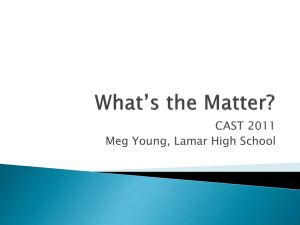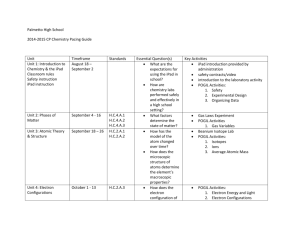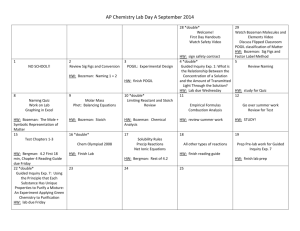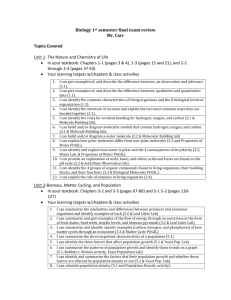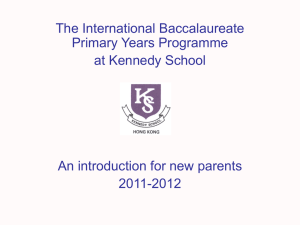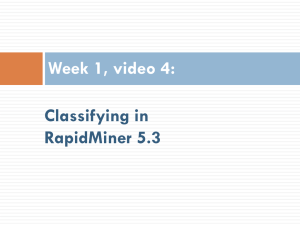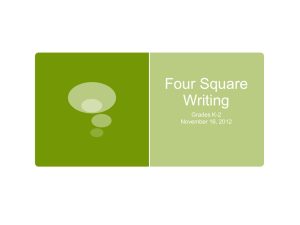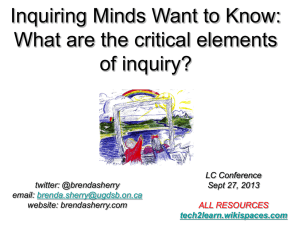Process Oriented Guided Inquiry Learning is a
advertisement
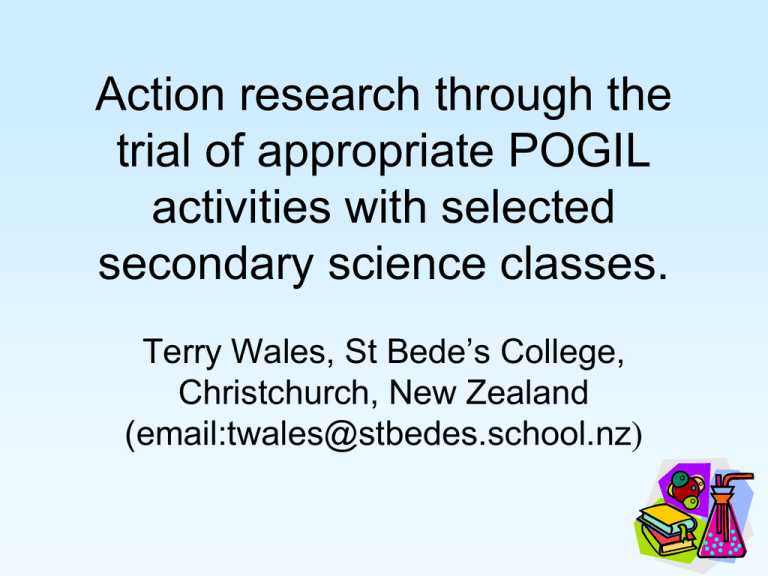
Action research through the trial of appropriate POGIL activities with selected secondary science classes. Terry Wales, St Bede’s College, Christchurch, New Zealand (email:twales@stbedes.school.nz) Abstract How important is the way science is taught? Many good students give up or just do not reach their potential. It seems often the more the teacher does the less the students do. Students do not always develop the understanding and skills they need to progress. Are we taking advantage of recent findings in “How People Learn” and “How the Brain Works”? Introduction Teaching science is becoming more complex • Science is changing. • The world is changing. • We know more about how learning takes place. The world is changing. • From a text-based society to an imagebased society. • New tools lead to changes in the curriculum. • Schools are changing. • Students are changing. We know more about how students learn. • Individual differences: – Learning styles – Cognitive styles • Student misconceptions & preconceptions • Importance of active learning School Science (situation at present) • Students: – Solve “problems” for which the answers are already known. – Report laboratory work by filling in blanks. – Memorise information. • School science is not ‘authentic’ science. • However, inquiry activities are authentic science. Criteria for inquiry • Students must: – – – – – – – be actively involved in the activity or simulation formulate questions make and check predictions design/carry out investigations collect, analyze, and explain data manipulate variables report results and compare them with accepted facts – develop scientific reasoning skills – be stimulated to learn more In inquiry learning students formulate questions. The Research Literature Shows. • Good lectures can be an effective means of instruction for teaching theory and concepts. • Problem-solving skills are taught more effectively in small cooperative groups. • Practical skills are taught more effectively in a hands-on laboratory setting. • Active involvement promotes learning. Using POGIL The integration of POGIL strategies into my science teaching is an attempt to: • engage students more in their own learning • make the material more interesting • help overcome various misconceptions • take some of the burden off the teacher POGIL Process-Oriented Guided Inquiry Learning (The active involvement strategy used in this study.) What is POGIL? Process Oriented Guided Inquiry Learning is a combination of… Process Oriented cooperative learning Conscious commitment to development of important process skills What is POGIL? Process Oriented Guided Inquiry Learning is a combination of… Process Oriented Guided Inquiry cooperative learning constructivism Information Processing Critical Thinking Problem Solving Communication Teamwork Management Assessment Learning Cycle Activities What is POGIL? Process Oriented Guided Inquiry Learning is a combination of… Process Oriented Guided Inquiry cooperative learning constructivism Information Processing Critical Thinking Problem Solving Communication Teamwork Management Assessment 1 Exploration 2 Concept Invention 3 Application Information Processing Model Events Observations Instructions Instructor P e r c e p t i o n F i l t e r X Working Memory previous knowledge preferences misconceptions Storing Long Term Retrieving Memory Students biases likes dislikes A. H. Johnstone, J. Chem. Educ. 1997, 74, 262. Gazzaniga et al. Cognitive Neuroscience, 1998. Guided Inquiry Approach • • • • Students work in groups Students construct knowledge Activities use Learning Cycle paradigm Students teach/discuss/learn from students • Instructors facilitate learning Typical POGIL activity (Y12) http://www.pogil.org CHARACTERISTICS OF POGIL MATERIALS • Designed for use with self-managed teams that employ the instructor as a facilitator of learning rather than as a source of information • Guide students through an exploration to construct understanding • Use discipline content to facilitate the development of higher order thinking skills N.B. • Due to the earthquakes in Christchurch over 2010/2011, the number of Pogil Lessons that were trialed was less than had originally been planned. • The amount of feedback and subsequent analysis was also less, due to time constraints. • However, sufficient lessons were still trialed at different Year levels, to get a good idea of their effectiveness in the New Zealand classroom. POGIL Students • Are actively engaged and thinking in class. • Learn how science is done by analyzing data and drawing conclusions. • Work together in self-managed teams to understand concepts and solve problems. Analysis of Student Outcomes What is “success”? Measures of success include: • Increased student satisfaction. • Fewer misconceptions. • More students continuing in the course sequences. • More M and E grades (for exam classes). • Fewer N grades and withdrawals (for exam classes). • Less voids in examinations. How did my students react to the active working groups? • Did students believe that cooperative groups helped them learn? (1 – 5) • Did students prefer group work or lectures alone? (1 – 5) (N = 98) Group work helped me to understand science better. Groups helped me develop problem-solving strategies. I would pick a class with group work over one without. POGIL activities used • Year 10: Classification of Matter pdf • Year 11: Chemical Formulas and Names of Ionic Compounds pdf • Year 12: Inside the Atom pdf Types of Solid pdf Empirical Formula and Molecular Formula Molarity pdf • Year 13: Electron Configurations pdf Trends in the Periodic Table pdf Intermolecular Forces and Strengths pdf Bond Enthalpies pdf pdf POGIL activity survey 2010 - 2011 • Was it a good inquiry-based activity? • Was content learned from the activity? • Was it an enjoyable activity? Was it a good inquiry-based activity? (1-10) Was content learned from the activity? (1-10) Some student comments about the materials • I thought it was interesting learning science this way because it is not something I have done in any other science class. • In all of my other science classes we only talked about the concepts, so here I learned what else was going on when the concept took place. • It was somewhat interesting, but I liked the hands-on activities a lot more and learned a lot more. My comments on one activity: Structure of an atom • I used this activity with my Year 12 class. The students were highly engaged with the topic. I always use the role cards, but I used two readers instead of one since the technician role wasn’t needed. • I reminded them that every student had to record their answers (Teenagers can do a lot with any down time!). To reinforce this I let the groups understand that only one set of answers was to be graded and the same grade awarded to each group member. I also made it clear this was going to be a random choice. • The students were challenged by the ion material. This was a good thing because it really made them inspect details closely. Next time, I may save the ion section for the next session. • I did provide them with periodic tables and that worked well. Where to from here? • The activities need to be revisited and modified in the light of the findings. Also, they will be given more of a New Zealand flavour. • These activities will be made available to other teachers and other schools. • Other suitable activities will be trialed by myself and other teachers at the school and added to this resource. • The results for examination classes will be compared to historical values to see if there is improvement. • The report/resource must be submitted electronically to: teacher.studyawards@minedu.govt.nz • It is preferable that the report is also added to the recipient school’s website and a link be submitted to the teacher study awards administrator.
